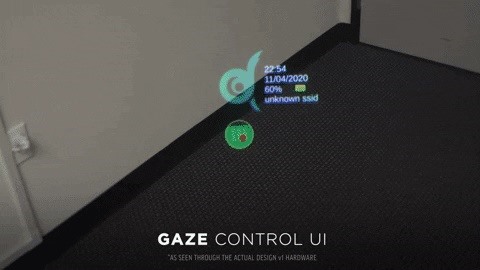In the great smartglasses race, component makers, such as those that supply the crucial waveguide displays that make visualization of virtual content possible, have a vested interest in pushing the industry forward in order to ship units.
On Tuesday, waveguide maker DigiLens unveiled Design v1, a reference design based on its Visualize Framework for smartglasses development, with the aim of helping original equipment manufacturers (OEMs), software and content makers, and IoT providers to jumpstart the development of their own augmented reality wearables.
- Don't Miss: DigiLens Previews Smartglasses with Its Waveguide Displays in New Video on Design & Manufacturing Approach
DigiLens will ship Design v1 units immediately to a limited set of hardware partners and expects to expand availability by early summer.
The DigiLens reference design, which runs on Qualcomm's Snapdragon XR2 computing platform, includes the company's Crystal50 waveguide lens, which yields a field of view of 50 degrees and brightness of 325 nits/lumen at 80% transparency with 400% less eye glow (the light from the optical engine illuminating the users' eyes).

Working within the Visualize Framework, partners can customize Design v1 with modular components, such as from faceplates, frames, and ear horns for aesthetics to inside-out tracking and SLAM, depth sensing, cameras, microphones, and spatial audio for technical performance, to arrive at a unique product.
"Design v1 is brighter, lighter, and more capable than any other waveguide-based XR device on the market. Our strategy is to empower the forward-leaning XR companies in the ecosystem to capitalize on the strengths of an emerging horizontal market," said Chris Pickett, CEO of DigiLens, in a statement. "We are creating an XR blueprint for the ecosystem to take, add to, and adapt as needed for their individual markets and their unique XR software development needs. Expanding the pool of experts and democratizing ideas across the spectrum is what the market has missed to date."

Previously, Niantic backed DigiLens via a Series C funding round in 2018, with Samsung eventually joining the round when it closed in 2019 with a total of $50 million.
Earlier this year, Niantic CEO John Hanke teased smartglasses carrying his company's wordmark. Based on Niantic's financial backing of DigiLens, we speculated that the device could be based on a DigiLens reference design. The modular nature of Design v1 serves as further evidence that Niantic's concept is based on the reference design from DigiLens.



Samsung is another company with AR smartglasses aspirations and a strategic investment in DigiLens. Design v1 would enable Samsung, as well as other device manufacturers, to take a shortcut in designing and producing their own smartglasses.
"Design v1 promises to be an excellent platform to offer our clients cost-effective head-worn devices with greater comfort and more processing power, ideally adapted to their use case," says Christian Guillemot, CEO of AMA. "We are looking forward to leveraging the benefits of Design v1 for our XpertEye remote assistance solution and continue to create value and amazing experiences for our customers."

DigiLens is not alone among component makers offering reference designs for use by OEMs. Waveguide competitors WaveOptics and Lumus, as well as DigiLens's own Visualize partner, Qualcomm, have also built their own reference designs. This is also not the first reference design from DigiLens, as this latest offering follows the Crystal reference design.
While it's the horse that gets the glory, the trainer also gets the credit. Likewise, while companies like Apple, Facebook, Snap, Google, Niantic, and Samsung will place their badge on their eventual AR wearables, companies like DigiLens will also reap the rewards.

Just updated your iPhone? You'll find new features for Podcasts, News, Books, and TV, as well as important security improvements and fresh wallpapers. Find out what's new and changed on your iPhone with the iOS 17.5 update.























Be the First to Comment
Share Your Thoughts